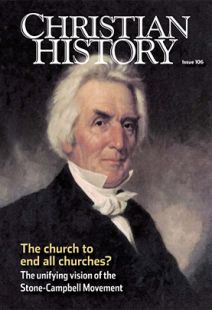Editor's note: Stone-Campbell movement
EVER OPENED UP someone else’s old photo album?
Grandparents, aunts, second cousins, old Ford Model Ts, big hats. Or boat cars and poodle skirts.People smiling into long-vanished sunsets and sunrises. At first, it seems confusing. Maybe you can pick out an era, but these aren’t your grandparents and your second cousins, your stories, or your inside jokes.
But then you talk to the people who own the photo album. You listen to their stories and the photos come alive. You learn what it meant to be part of that family in all its struggles and heartaches and joys. What it meant to live at that moment in history.
Telling the story
A while ago, some folks from the Stone-Campbell Movement approached us about wanting to tell their story. To open up their old photo album, so to speak. If you didn’t grow up in the movement, you may not even have heard of them or know that they are often referred to by the names of their founders, Barton Stone and Thomas and Alexander Campbell.
Many of us come from Christian groups that take the Bible very seriously and may have even started because a group of people wanted to get “back to the Bible.”
Stone and the Campbells were no different. But the movement they created went whole hog.
There were no sects or denominations in the New Testament; so they claimed they were simply “Christians,” and subscribed to no creed but the Bible. There were no musical instruments in New Testament worship; so they worshiped without instruments. There were no organized missionary societies; so they refused to organize for the support of missionaries. What they did see in the New Testament was a unified group of Christ-followers with equality before God who baptized by immersion and shared Christ’s holy meal together every Sunday. So that was who they became.
Eventually, and ironically, disagreements over all these issues led to their separation into three different “streams.” One stream even became a denomination, quite self-consciously. In the process of defining themselves, they went by a dizzying array of names for being “simply Christian” (which are spelled out in our “How to speak Stone-Campbell” glossary on pp. 14–15; terms in the glossary appear in bold throughout the rest of the issue).
What does this photo album teach the rest of us? Things we already knew, but things it is good to remember. The centrality of the Bible. The centrality of the body of Christ. How American culture and the Christian message influenced each other.
And how difficult it is to be “simply Christian.” Even when you go whole hog. Traditions and human constructions can turn out to be, in the end, inescapable. But also inescapable, in the end, is the grace of God. Thanks be to God, who redeems all constructions. CH
Jennifer Woodruff Tait
Managing editor
A note from the CH Intern
Special thanks to Richard Hughes for his patience in waiting for an issue on the Stone-Campbell Movement. In the midst of cleaning out my grandfather Ken Curtis’s office, we discovered a letter Dr. Hughes wrote in the 1990s proposing an issue on this topic.
I reconnected with Hughes when I was privileged to have him as a professor at Messiah College last year. When he discovered my connection to the magazine, his interest re-emerged. We are grateful for his hard work as a scholar-advisor and writer for this issue. Thank you, Dr. Hughes, for persisting in your dream to make an important piece of Christian history accessible to the rest of us! —Michelle Curtis
All images credited “Doug Foster” are courtesy of the Disciples of Christ Historical Society, Nashville, Tennessee, or the Center for Restoration Studies of Abilene Christian University, Abilene, Texas. CHM also thanks Sara Harwell, vice president and chief archivist at the Disciples of Christ Historical Society, for her assistance in providing images.
By Jennifer Woodruff Tait
[Christian History originally published this article in Christian History Issue #106 in 2013]
Next articles
No name but the name of Christ
The beginnings of the Stone-Campbell movement
D. Newell Williams and Douglas A. FosterWho was that white-robed man?
Joseph Thomas, “the White Pilgrim,” tried to be as apostolic as possible
Richard HughesHow to speak Stone-Campbell
What do they mean when they say . . . ?
Douglas A. Foster and McGarvey IceSupport us
Christian History Institute (CHI) is a non-profit Pennsylvania corporation founded in 1982. Your donations support the continuation of this ministry
Donate



